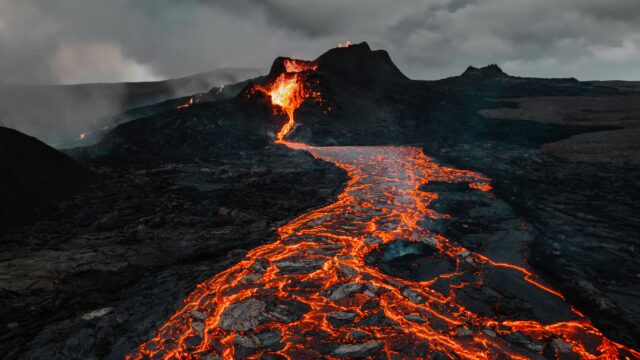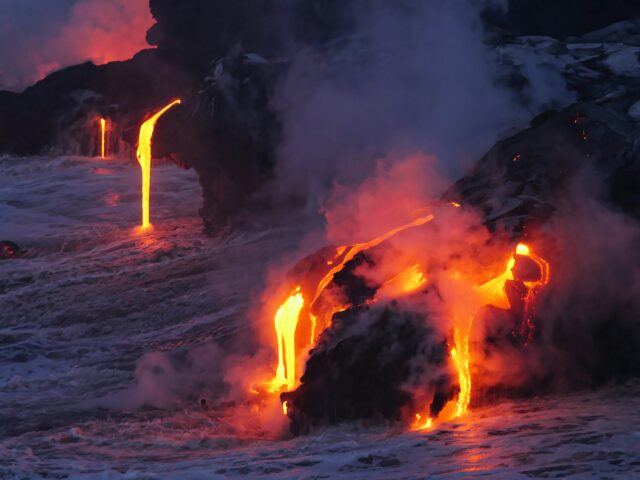Dear readers,
Many years ago, long before I moved to Hawaii, I took a trip to the Big Island with my then-partner. Like many tourists, we started out by consulting a variety of guidebooks and websites, intent on hitting all the best spots and anxious not to “miss” anything. We packed snorkels, fins, and hiking boots, and made lists of beaches we wanted to see and forests we wanted to explore.
On the third night of our trip, we drove out to the eastern side of the island, where it was still possible to watch molten lava flowing into the ocean. In the busy parking lot of the hiking trail leading out to the lava, we met an old man who had lived on the island for many decades. After chatting with him for a few minutes, he seemed to accept us as kindred spirits. With a twinkle in his eye, he told us about a second, lesser-known trail which would bring us even closer to the flowing lava.
As a light rain began to fall, we thanked the man for his advice and set out in the direction he pointed. The hardened black lava felt strange beneath my feet—sometimes rounded and pillowy, sometimes jagged. I would later learn that the names for these two types of lava are pahoehoe and 'a'ā respectively. Here and there, wisps of steam rose up from narrow cracks in the rock. The wind picked up, and I could smell sulfur on the air. As we headed further and further away from the main trail, I felt a twinge of excitement, with a dose of guilt and worry mixed in. Was this okay?
When the glowing orange lava came into view, my thoughts fell away, replaced by an overpowering sense of awe. Here was the planet, creating itself. The sight of it was so hypnotic I couldn’t look away, but gazed intently, worshipfully, as the radiant substance meandered slowly across the hardened lava beneath, its surface crackling as it cooled. The rain fell harder, sizzling audibly against the molten lava, and the wind picked up. I zipped up my rain jacket and pulled my hood over my ears. Although I knew this place would be special, I wasn’t prepared for the raw power I beheld.
Then I heard a new sound: a woman chanting in Hawaiian. Looking over, I saw a small group of people standing near the other side of the flow, their bodies lit up only by the glow of the lava. Although I couldn’t understand the woman’s words, it was clear that her chant was a kind of invocation—a way of acknowledging Pele, the goddess of lava, and perhaps also of asking permission to be in her sacred home. I stood completely still, listening to the long and serious chant, and watching the lava’s slow unfurling.
I knew, then, that even though I felt extraordinarily lucky to be there, it was also wrong. I hadn’t sought permission to be there, and hadn’t observed the protocols appropriate to that place. Like many tourists, I’d let my eagerness to have an experience outpace my understanding of the culture, the spiritual traditions, and the geography of the place I was visiting. The chanting woman had appeared as a kind of teacher, giving me a glimpse of the proper way to behave. It was now my responsibility to continue learning.
Since then, I have learned that the singing I had heard was an oli: a Hawaiian chant usually performed by a single person, without the accompaniment of musical instruments or clapping. Although oli can serve many purposes, they are often used as a way of introducing yourself when you go to a new place—letting the land know who you are and what you intend, and perhaps asking for protection and guidance while you are there.
Over the years I’ve lived in Hawaii, I’ve heard oli in many settings. Wandering through the valley where I live, I’ve come across people chanting oli at the spring, the beach, the taro lo’i, or beside an old grave. At the beach clean-up and habitat restoration events I attend, it’s customary for the group to pause and the leader to chant oli before the volunteers set forth with their shovels and buckets. The sound of oli is deeply moving and sometimes eerie, putting the listener in a state of deep reverence for the land on which they walk. Oli reminds me of the power of place, and the importance of bringing an attitude of respect and curiosity to the lands I visit.
Once, a friend of mine invited me to snorkel with her in a part of the ocean I’d been too timid to visit before. Our journey would involve swimming through a narrow crack in the rocks, through a churning tunnel of white water, and out into the deep blue part of the bay. I was nervous. For one thing, I don’t like tight spaces—and I like them even less when I’m blinded by millions of tiny bubbles, wondering if I’m about to barrel straight into a rock. But even more importantly, I knew that the deeper part of the bay is where the sharks hang out, and at the time, I was very nervous about trespassing into the sharks’ home.
But my friend was a woman in her sixties who hardly struck me as a daredevil. If she routinely took this journey, how treacherous could it really be? We got in the water, and I followed her to the edge of the coral, where a wall of lava rocks rose above the sea. My heart skipped a beat as we approached “the keyhole”—the narrow gap I’d always been too scared to swim through. She swam through first, and I followed, kicking my fins like crazy through the blinding surge.
I swallowed a mouthful of saltwater and came up sputtering but otherwise unharmed. The ocean felt huge outside the safe confines of the inner bay. My mind began to flood with anxiety as I considered how far we were from land, and how hard we would have to swim if the currents picked up.
“I like to sing an oli when I get here,” said my friend. “To let the sharks know I’m around.”
She pushed her goggles onto her forehead and began to chant in a strong, confident voice. I treaded water, gazing out at the endless blue ocean. As I listened to her singing, my heart rate began to slow down. It seemed to me that her chant was truly protective—perhaps in a mystical sense, but also because it was calming, and there is nothing more important than staying calm when you’re in the ocean. I imagined the sharks could hear her respectful offering, and I felt better knowing that we weren’t rudely barging in on them, but announcing our presence at the door. I was used to feeling anxious in deep water, but for the first time, I was also overcome by a sense of peace. I felt connected to the place, as if the vibrations of my friend’s voice formed a kind of bridge or tether, uniting what was separate before.
This May, Insight Events USA is holding the annual Gathering of the Shamans in Sedona, Arizona. Just like Hawaii, Arizona is filled with sacred sites, often referred to as vortexes. Simply being in the presence of these sites, with their red rock and deep quiet, is known to elevate the spirit and calm the mind. The Sedona Mago retreat center, where the Gathering of the Shamans is being held, is surrounded by the mountains and canyons of the Coconino National Forest, a 1.9-million-acre natural wonderland, where participants can experience starry skies and the peace that emanates from ancient land.
I’ve never been to Arizona before, but with teachers like Rhonda McCrimmon, Jose Luis Stevens, and Linda Star Wolf in attendance, I’ve been staying up late looking at flights. It’s been a long time since I’ve been to a new place—my off-grid homestead keeps me busy, and most weeks I hardly make it further than the post office, if I leave my land at all—but as I look at photos of Sedona’s red rocks, I have to admit I feel an inner stirring to go. With teachers coming from a variety of different lineages and backgrounds, the Gathering of the Shamans feels like a true meeting of minds and spiritual traditions, of the type that can be hard to find in the segmented modern world.
I don’t know if the people indigenous to Arizona have a practice similar to Hawaii’s oli, but I do know this: the next time I visit a new place, I’ll go there as a student, not a tourist. There are lessons in the land, if we know how to listen, and skillful teachers to help us understand them, wherever we go.
Sincerely,
Hilary T. Smith
Senior Editor, Hierophant Publishing


